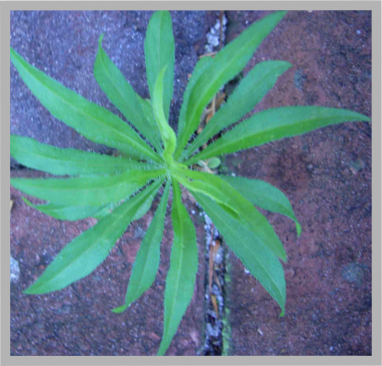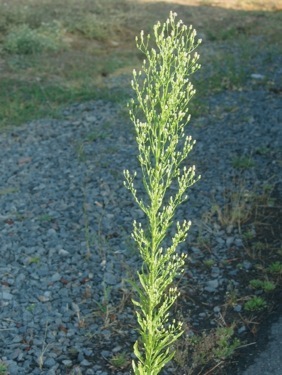Conyza canadensis: Herb, Fire, Food
Conyza will light your fire!
If you’ve ever made fire with a bow and drill — you know, the Boy Scout way — you also know that choosing (or finding) the right materials is absolutely essential for you to create fire. Add to that a medicinal herb and some culinary uses and “horseweed” deserves a place among the useful weeds we should know about.
A native of North America, Conyza canadensis is now found around the world. First listed in North America in 1640 it was in France 13 years later (presumably via seeds on beaver pelts from Canada.) Native Americans used a tea from the leaves to treat dysentery and a tea from the boiled root for menstrual issues. It’s a diuretic and can make you sweat. Horseweed has also been called Fleabane because the leaves put in pets’ beds help to get rid of fleas.
As for food, young leafy seedlings and young leaves can be eaten after boiling, dried leaves can be used as a seasoning with a flavor similar to tarragon. American Indians pulverized the young tops and leaves, eating them raw, similar to using an onion. Per 100g of dry weight the leaves have a small amount of protein and fat, more fiber, good amount of carbohydrates, 8.2 grams ash, 1010 mg of calcium, 280 mg phosphorus, and 2610 mg potassium. An essential oil of Conyza is used to flavor candy, condiments and soda. Fresh leaves contain 0.2 – 0.66% essential oil.
Botanically Conyza canadensis (CON-knee-zah, con-KNEE-zah, con-NEIGH-zah kan-ah-DENSE-iss) means flea from Canada. Conyza comes from the Greek word konops, meaning flea. Pliny used the name for a fleabane, which was put in pet and human beds to keep away fleas.
Conyza canadensis can easily be confused with Conyza sumatrensis and Conyza bonariensis. Conyza canadensis is distinguished by hairless or nearly hairless bracts which lack a red dot at the top but have a brownish inner surface. Conyza sumatrensis has hairy bracts but there are no long hairs near the top of the bracts. Also inner surface of bracts are reddish brown. Conyza bonariensis has densely hairy bracts, and is especially hairy on the stems and around the leaf axils.
While native to North America C. canadensis can be found in The European part of the former USSR, the Caucasus, Western and Eastern Siberia, the Far East, Central Asia, Scandinavia, Middle and Atlantic Europe, the Mediterranean, Asia Minor, Iran, Mongolia, Japan, China, and Australia.
The horseweed is also one of the best, if not the best local material for a drill when making fire with friction. Actually too fragile to be used with a bow, it works very well using the hand method. As you might expect, choose tall straight plants, let dry, remove leaves, and you’re ready. Horsetail is so good often you don’t even need a V-notch to collect a coal, it will produce one in just a depression.
Green Deane’s “Itemized” Plant Profile
IDENTIFICATION: Annual, one to seven feet tall, unbranched except for the flowering stems near top. Central stem ridged, covered with long white hairs; leaves alternate around this stem appearing whorled, similar length, 3-4″ long and ½” across, narrowly lanceolate or oblanceolate, a few teeth toward outer tips, fine white hairs along the edge. Smaller leaves near the blossoms more linear and less likely to have teeth. Many composite blossoms less than 1/8 of an inch across, lasting several weeks.
TIME OF YEAR: Summer to fall
ENVIRONMENT: Prefers full sun and good soil, well watered. But it can grow nearly anywhere, often forms colonies. Drought resistant.
METHOD OF PREPARATION: Dried leaves as a spice, very young leaves and shoots as a green boiled. Stem makes good drill for fire starting.



